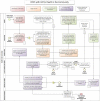Integrating community-based verbal autopsy into civil registration and vital statistics (CRVS): system-level considerations
- PMID: 28137194
- PMCID: PMC5328373
- DOI: 10.1080/16549716.2017.1272882
Integrating community-based verbal autopsy into civil registration and vital statistics (CRVS): system-level considerations
Abstract
Background: Reliable and representative cause of death (COD) statistics are essential to inform public health policy, respond to emerging health needs, and document progress towards Sustainable Development Goals. However, less than one-third of deaths worldwide are assigned a cause. Civil registration and vital statistics (CRVS) systems in low- and lower-middle-income countries are failing to provide timely, complete and accurate vital statistics, and it will still be some time before they can provide physician-certified COD for every death. Proposals: Verbal autopsy (VA) is a method to ascertain the probable COD and, although imperfect, it is the best alternative in the absence of medical certification. There is extensive experience with VA in research settings but only a few examples of its use on a large scale. Data collection using electronic questionnaires on mobile devices and computer algorithms to analyse responses and estimate probable COD have increased the potential for VA to be routinely applied in CRVS systems. However, a number of CRVS and health system integration issues should be considered in planning, piloting and implementing a system-wide intervention such as VA. These include addressing the multiplicity of stakeholders and sub-systems involved, integration with existing CRVS work processes and information flows, linking VA results to civil registration records, information technology requirements and data quality assurance.
Conclusions: Integrating VA within CRVS systems is not simply a technical undertaking. It will have profound system-wide effects that should be carefully considered when planning for an effective implementation. This paper identifies and discusses the major system-level issues and emerging practices, provides a planning checklist of system-level considerations and proposes an overview for how VA can be integrated into routine CRVS systems.
Keywords: Mortality surveillance; Sustainable Development Goals; cause of death; health information systems; information technology; international classification of disease; process mapping; systems integration.
Figures





References
-
- AbouZahr C, de Savigny D, Mikkelsen L. Towards universal civil registration and vital statistics systems: the time is now. Lancet. 2015;386:1407–14. - PubMed
-
- Mikkelsen L, Phillips DE, AbouZahr C. A global assessment of civil registration and vital statistics systems: monitoring data quality and progress. Lancet. 2015;386:1395–1406. - PubMed
-
- Phillips DE, AbouZahr C, Lopez AD. Are well functioning civil registration and vital statistics systems associated with better health outcomes? Lancet. 2015;386:1386–1394. - PubMed
MeSH terms
Grants and funding
LinkOut - more resources
Full Text Sources
